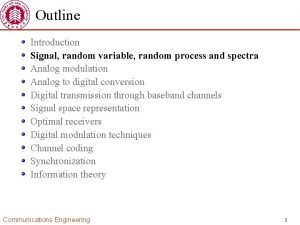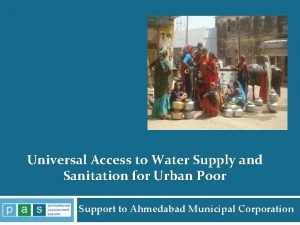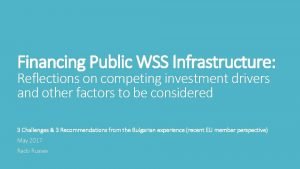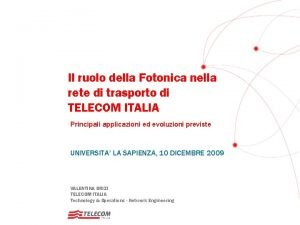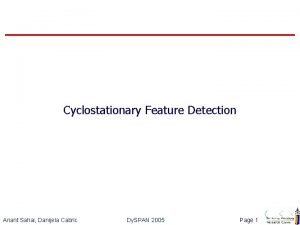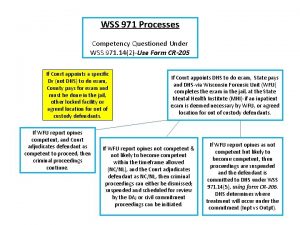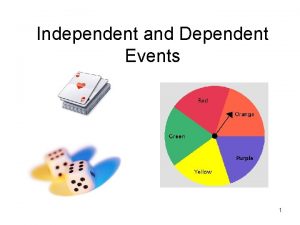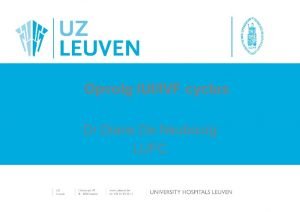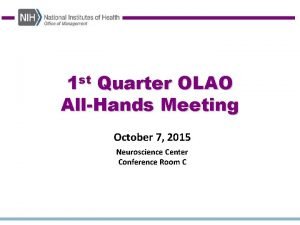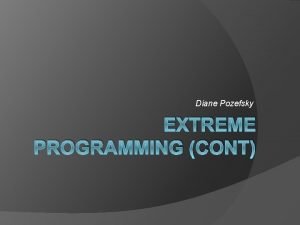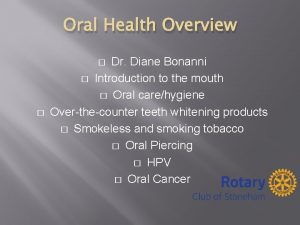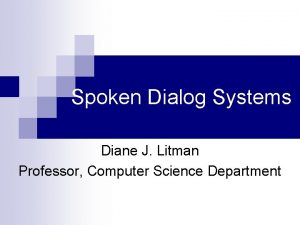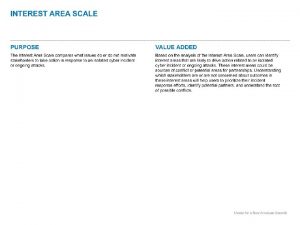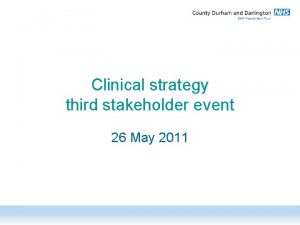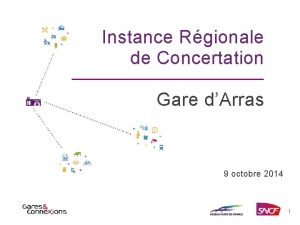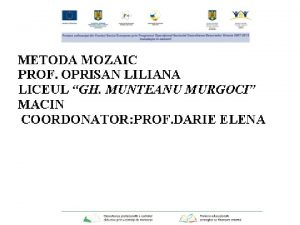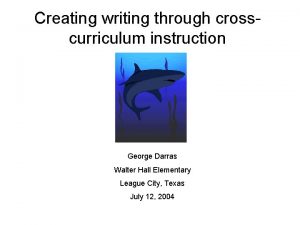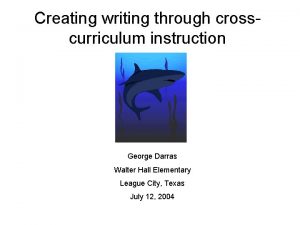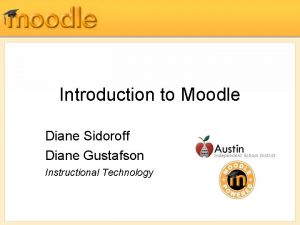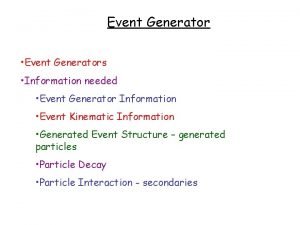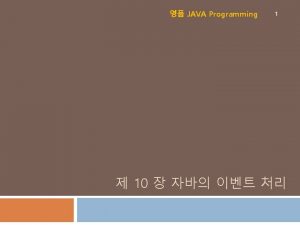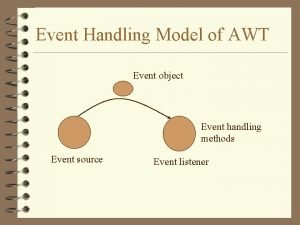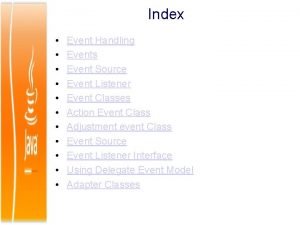Wss TP Third Stakeholder Event Diane dArras Wss

























- Slides: 25

Wss. TP Third Stakeholder Event Diane d’Arras Wss. TP Chair

What is the Wss. TP? 1. The Water Supply and Sanitation Technology Platform 2. a legitimate European Research & Technology development platform. 3. recognized by the EC and National governments as the reference in Research & Technology water sector. 4. a transparent and official NGO association.

The objectives of the Wss. TP 1. The Wss. TP has delivered a Vision. 2. From Fundamental Research to implementation, the Wss. TP is proactive in identifying with future challenges. 3. It aims to facilitate the set up of transnational programmes�through: • Relationship with EC, through MSMG. (Advices, proposals, strategic topics. . ) • Frequent workshops, conferences. • Publications (reports & abstracts). • A large contribution to European programmes The Vision Document and The Strategic Research Agenda have to be looked regularly and adapted if necessary

Vision Document and Strategic Research Agenda have to be looked regularly and adapted if necessary THIRD STAKEHOLDER EVENT In Berlin in order to facilitate exchanges On “crisis and risk management” First part What are the impacts of the financial crisis and the priorities for the research sector ? Second part How to deal with risks management in the water sector?

Review of the SRA in the context of the crisis

Three majors drivers Worldwide, the water sector is facing a dramatic evolution because of three major “drivers”: • Climate change • Existing infrastructure is aging and deteriorating • Population growth Is the financial crisis a fourth driver? > Review of SRA taking in account the crisis challenges

Challenges Challenge 1: Increasing water stress and water costs Many areas suffer from water stress, and the severity of that stress is increasing. Water stress may be primarily a water quantity issue, but it can also occur as a consequence of a deterioration of water quality or lack of appropriate water management. > To solve quantity issues investments can be replaced by a consumption management > But quality issues have to be solved by treatments investments

Challenges Challenge 2 : Urbanization Rapidly increasing urbanization is one of the most distinctive changes of the 20 th and early 21 st centuries: the challenge or urban and peri-urban areas is the unpredictability and the rate of migration, which makes it difficult to plan and ensure appropriate water services. Urban areas around the world suffer from old and deteriorating water infrastructures that are very vulnerable to failure due to aging, damage from excavations ore over-loading. > Limit of investments during crisis will raise risks on network management

Challenges Challenge 3 Extreme events Climate change has an impact upon the frequency and severity of extreme events (droughts, floods, heat waves or blizzards). Floods and droughts can be worsened by poor land management and need to be tackled in an integrated way. > For the time being we need to develop tools and technologies first to anticipate, second to manage these events. Postponing those “investments” won’t let us understand the real impact of climate changes.

Challenges Challenge 4 Rural and under-developed areas Many rural and under-developed areas within and outside Europe lack any significant infrastructure for water services. Frequently, wastewater and agriculture water management have an adverse impact on water quality in small settlements without people being even aware of these hazards. Municipalities and regional or national government often lack the money and the know-how to initiate the needed development. Public and authorities not accepting the real cost (when they do for their telephone and electricity) > Crisis will widen gaps

Research areas Areas of research Five areas of research have been identified to meet the major challenges the water sector faces • Balancing demand supply • Ensuring appropriate quality and security • Reducing negative environmental impacts (agriculture, wastewater) • Novel approaches to the design, construction and operation of water infrastructure assets • Establishment of an enabling framework

Research areas R 1: Balancing demand supply What research is necessary to achieve this goal ? • Water saving concepts and technologies. • Increased knowledge of water quality requirements for all applications and purposes. • Technologies which enable usage of new and alternative resources of water, including wastewater. • Aquifer recharge and recovery technologies. • Decision support systems and demand management systems to efficiently allocate and use water resources. > In areas with water resource constraints, balancing the demands for water between the various sectors will be even more important than before > Raise needs for more anticipation & technologies

Research R 2: Ensuring areas appropriate security It is essential that the quality and security of water supply and sewerage services are ensured (quantity, quality) What research is necessary to achieve this goal ? • Management of risks, best practice at all levels of the water cycle • Availability of comprehensive water quality and nutrient monitoring tools, including early warning systems for pollution and pathogen detection • Availability of emergency water supply tools > monitoring tools are necessary and the development of that tools can be a way of boosting the economy >More necessity to set priorities in investments which means better tools for “Risk management”

Research R 3: Reducingareas negative environmental impacts A reduction in the negative environmental impacts that water users can have upon the water cycle and greenhouse gases. What research is necessary to achieve this goal ? • Better methods & tools to set environmentally sustainable river flows • Better technologies for monitoring, controlling and removing diffuse and point source pollution • Reduce energy consumption & produce less waste in the water cycle • Develop usable products from sludge recovered during wastewater treatment in order to save energy and protect environment • Develop rain water management systems > Focus on eco. technologies to reduce energy consumption, monitor and protect water resources and develop eco. enterprise

Research areas to the design, construction and R 4: Novel approaches operation of water infrastructure assets What is the goal ? Extensive water distribution, flood protection, irrigation, drainage and sanitation infrastructure have been built over the past two centuries, both above and below ground. Many assets are more than 100 years old, requiring rehabilitation or replacement. What research is necessary to achieve this goal ? • New integrated concepts for water distribution and re-use. • Smart asset management strategies software. • Technologies and analytical methods to assess the condition and remaining life of assets. • Better understanding of deteriorating & disturbing processes. • Advanced technologies to maintain, replace and renew existing assets (without digging). > Investment for rehabilitation will decrease > Increase need for anticipation and strategies and risks management tools

Research areas of an enabling framework R 5: Establishment What is the goal ? To break the four major barriers for cross cutting issues impeding the deployment of integrated water solutions: compliance with regulations and directives, public and political acceptance, financing of infrastructure & water value pricing. Knowledge needed to achieve this goal • Trends in economic globalisation & its impact on water systems issues • Trends in climatic changes and their potential impact on the availability of quality water for all communities and the adverse effects of extreme events • Major driving forces governing political decisions and legal compliance • Overall expectations of every community of users in terms of availability and quality of water, environmental impact, affordability and economics provision > It should include trends of loss of investment capacities, slower economy and financial crisis

Conclusions • Financial crisis increases identified challenges > raise the need for research, settling priorities and fundings • Increase need to work together, synergies • Raise need for anticipation, planning, forecast technologies • Confirm the interest of risk management in the water research • Question the available fundings available, how to avoid duplication / combine financial resources

Thank you for your attention

Integration - Pilots Pilot Programmes & the crisis Six programmes have been identified to address the four major challenges for sustainable water management for Europe Pilot 1: Mitigation of water stress in coastal zones Pilot 2: Sustainable water management inside and around large urban areas Pilot 3: Sustainable water management for agriculture Pilot 4: Sustainable water management for industry Pilot 5: Reclamation of degraded water zone (surface water & groundwater) Pilot 6: Proactive & corrective management of extreme hydro-climatic events

Mitigation of water stress in coastal Main challenges for pilot programmes: Mitigation of water stress in coastal zones Coastal zones occupy less than 15% of the earth’s surface but accommodate over 70% of the world’s population (at less than 100 km from the shore). The coastal ecosystems are threatened by unsustainable development as a result of rapid demographic growth and agriculture, industry and tourism developments.

Sustainable water management Main challenges for pilot programmes: in: Sustainable water management inside and around large urban areas side • Urban areas, and especially large or densely inhabited ones, raise specific issues in terms of water management. • The key objectives are the reduction of the ecological footprint of urban areas on water resources, as well as a fair and efficient interdependence and co-ordination with surrounding areas. • Diagnosis, decision support and management tools need to offer solutions from real time to long term, and to integrate multiple stakes and aspects. • Infrastructures are ageing and have to be renewed on an efficient basis.

Sustainable for Main challengeswater for pilot management programmes: Sustainable water management for agriculture The agricultural sector is by far the largest consumer of fresh water. Worldwide, agriculture accounts for two thirds of all water used, mainly for irrigation. In Europe about 30% of the abstracted fresh water is used for agricultural purposes and up to 73% in Southern Europe. The objective is to implement technologies and methods that will make it possible to meet future challenges for environmental protection, impacts of global change, increasing economic competition and change of land use in agricultural areas.

Sustainable water management Main challenges for pilot programmes: for Sustainable water management for industry Water is of prime importance for the industrial sector as it is used in a variety of ways for transport, cooling and heating, cleaning, washing and also as raw material. Major water using and/or discharging industries include pulp and paper industry, textile, leather, oil/gas, chemicals/pharmaceuticals, food, energy and metal (including steel). The industrial sector is of great economic importance, where water related cost can reach up to 25% of the total production cost. The objective of this pilot is to implement technologies and methods, in support of the vision that water is a highly valuable asset.

Reclamation offor degraded water zones Main challenges pilot programmes: Reclamation of degraded water zone (surface water & groundwater) (surface and groundwater) European rivers and lakes are of great importance for our economies and our wellbeing, but more generally they support crucial ecologies that make up our natural environment. Since the industrial revolution human pressures have increased with rapid economic growth, urbanization and uncontrolled exploitation of our water systems. Rivers have been damped, lakes have been used as dump sites, and coastal waters have been used as seemingly unlimited sinks for the effluents of our cities. As a consequence many of our waters have been degraded. At the launch of the Water Framework Directive (WFD) 20% of European surface waters were seriously threatened, 60% of its ground waters were over-exploited and 50% of its wetlands had “endangered” status mainly due to lack of treatment, over-exploitation lack of environmental legislation in the past.

Proactive and corrective manage. Proactive & Main challenges for pilot programmes: corrective management of extreme hydro-climatic events of extreme hydro-climatic The central-European floods in August 2002 and the extremely dry conditions during the summer 2003 highlight the fact that Europe is both exposed and vulnerable to these types of hazards. Recent work on climate change indicate that such hazards are likely to become more frequent with warmer wetter winters and drier, hotter summers in different parts of Europe. Droughts have proved to be the most costly of all major hazards while being perhaps the least understood. On a global scale, floods account for over 65% of people affected by natural disasters and they are the most damaging of all natural disasters. Whether this is caused by increasing urbanization, climate change or other mechanisms is currently under debate. Forecasting is a sustainable way of adapting to and managing such disasters.
 Stochastic processes
Stochastic processes Wss
Wss Wss.uwinnipeg
Wss.uwinnipeg Jane eyre ending
Jane eyre ending Valentina wss
Valentina wss Wss process
Wss process Wsš
Wsš Wss 274
Wss 274 Cavity classification
Cavity classification Gingival third vs cervical third
Gingival third vs cervical third Independent event vs dependent event
Independent event vs dependent event Near miss examples ppt
Near miss examples ppt Bridge breaks in central java
Bridge breaks in central java Swot event management
Swot event management Compound probability examples
Compound probability examples Chaernobyl
Chaernobyl Independent or dependent
Independent or dependent Diane ketone
Diane ketone Thin lens simulation
Thin lens simulation Diane sudduth
Diane sudduth Diane de neubourg
Diane de neubourg Diane frasier nih
Diane frasier nih Diane pozefsky
Diane pozefsky Tooth fracture
Tooth fracture Dr diane wight
Dr diane wight Diane litman
Diane litman
